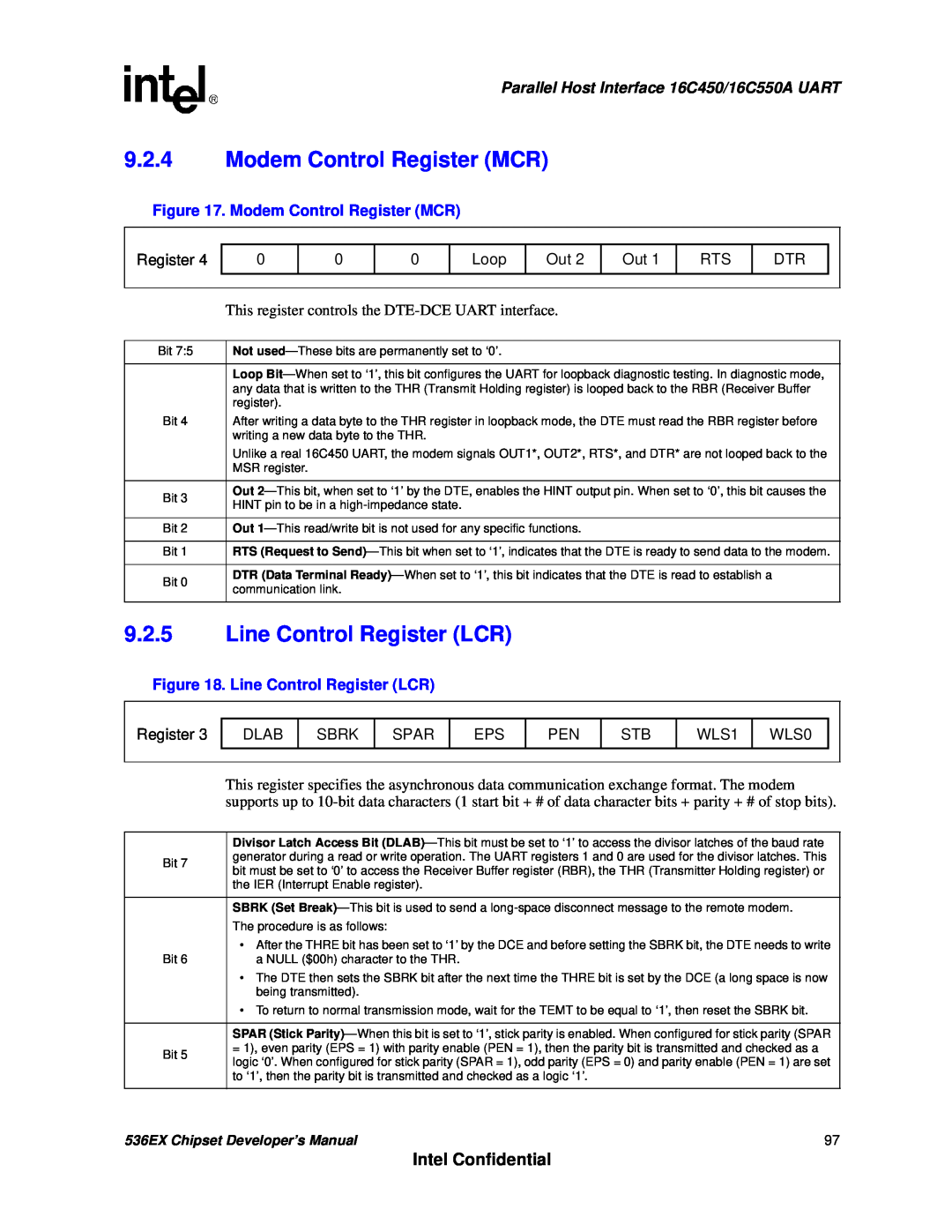Developer’s Manual
536EX Chipset
January
536EX Chipset Developer’s Manual
Intel Confidential
Contents
Contents
Figures
Tables
Date
Revision History
Revision
Description
1.1Controllerless Modem Driver Overview
Introduction
1.1.2Windows 95 and Windows
Figure 1. WDM Driver Block Diagram
User applications
Kernel - ring0
1.2V.90/V.92 and V.34 Data Modes
Figure 2. VxD Mini Port Driver Block Diagram
1.3Modem Connection Overview
Table 2. DCE-to-DCEData Rates for Each Mode
Table 1. DTE-to-DCEData Rates for Each Mode
Table 3. DCE-to-ISPData Rates for V.90 Mode
Table 4. DTE-ModemData Rate Response Codes
1.4.1Sending Commands
1.4.3Dial Modifier
1.4.2AT Escape Sequences
AT Command Summary Tables
AT Command Summary Tables
Table 5. Data Mode Command Summary
Table 5. Data Mode Command Summary Continued
Result code type
Table 5. Data Mode Command Summary Continued
Generate data mode calling tone
Table 6. V.44/V.42/V.42 bis MNP Command Summary
Intel Confidential
Table 8. Fax Class 1 Command Summary
Table 7. Fax Identity Command Summary
Table 10. Voice DTE→DCE Character Pairs
Table 9. IS-101Voice Command Summary
Table 11. Voice DTE←DCE Character Pairs
Table 10. Voice DTE→DCE Character Pairs Continued
Table 12. Dial Modifiers
Table 11. Voice DTE←DCE Character Pairs Continued
Table 13. S-RegisterSummary
Table 13. S-RegisterSummary Continued
Data Mode AT COMMANDS
Data Mode AT COMMANDS
Figure 3. Example of a Remote Connection
Table 14. Data Reporting Wn Mapping
ATW0
•ATW2
Intel Confidential
+FMFR?, +FMDL?, +FREV?
3.7Hanging Up Hn, S10, Zn, &D2
3.6Online Command Mode Escape Codes, On
3.8Modem-to-ModemConnection Data Rates
Intel Confidential
+PCW=0
+PMH=0
+VCID=1
+++AT
Intel Confidential
hook to connect the call. Now you can answer the phone and talk. After completing your voice conversation, the modem will issue another +PMHF and ATO command to initiate a Quick Connect. If the server rejects the request to go on hold, the user can stay on line ATO command issued or disconnect from his initial data connection ATH command issued
Table 16. Supported Modulation Types
3.9.1Local Analog Loopback AT&T1
3.9Diagnostic Testing S18, &Tn
LOCAL MODEM
3.9.2Local Analog Loopback With Self-TestAT&T8
Figure 6. Local Analog Loopback Test
Local Modem or Test Modem
Licensing Requirements for Hayes Escape Sequence
3.10.1Time-IndependentEscape Sequence
Format
<char1><char2><char3><AT command><contents of S3>
char1 = char2 = char3 = escape character S2
3.10.2Hayes* Escape Sequence
Table 18. Data Mode Command Descriptions
Intel Confidential
Sn=x
Intel Confidential
Data Mode AT COMMANDS
536EX Chipset Developer’s Manual
NOTE: An asterisk * denotes the factory-defaultsetting
AT&V0
Intel Confidential
Indication
Command Default
Definition
1, 0,
Intel Confidential
+ETBM
+ESR
1, 1,
+GSN
+GMR
+IFC
+ILRR=m
Intel Confidential
Description
<carrier>
+MS=m
see ‘m’
+PMHF
+PHSW=
<value>
+PMHR
Intel Confidential
Error Correction and Data Compression
Error Correction and Data Compression4
Table 19. Operating Modes
NOTES
Table 20. Resulting +ES Connection Types
Intel Confidential
Error Correction and Data Compression
536EX Chipset Developer’s Manual
Intel Confidential
direction
+DR=m
+DS=m
<max string>
+EFCS=m
3768
+ER=m
+ES=m
5.1Fax Identity Commands
Fax Class 1 AT Commands
5.2Fax Class 1 Commands
Fax Class 1 AT Commands
Table 23. <mod> Selection Table
Figure 8. T.30 HDLC Frame Format
Table 24. Fax Mode Command Descriptions
+FRH=m
Table 24. Fax Mode Command Descriptions Continued
Refer to Table 23 on page
shown in Table 23 on page
+FTH=m
IS-101Voice Mode AT Commands
IS-101Voice Mode AT Commands
6.1DTMF Detection Reporting
Table 25. Voice Mode Command Descriptions
6.2Relay Control
m = <deassert>, <assert>
+FLO=m
+VDR=m
m=<enable>, <report>
+VEM=m
m = <mask>
Intel Confidential
+VIP
+VLS=m
Preassigned Voice I/O Labels
Relay/Playback Control: cont
Voice I/O Primitive Codes
m = <sds>, <sdi>
+VRX
+VSD=m
+VSM=m
m= <cml>, <vsr>, <scs>, <sel>
Transmission: Range:
+VSP=m
Compression Method Selection: cont
factory default is ‘0’
none
+VTS=m
Default
Command
Description
DTMF and Tone Generation: cont
Table 26. S-RegisterCommand Descriptions
S-Registers
S-Registers
S-Registers
Intel Confidential
536EX Chipset Developer’s Manual
S-Registers
Intel Confidential
536EX Chipset Developer’s Manual
S-Registers
Intel Confidential
536EX Chipset Developer’s Manual
S-Registers
Caller ID
Caller ID
Table 27. Caller ID Tags for Formatted Reporting
RING RING
RING DATE = TIME = NMBR = NAME = DOE JOHN MESG =
<DLE> R
NMBR =
UART
Parallel Host Interface 16C450/16C550A
Parallel Host Interface 16C450/16C550A UART
Figure 11. UART Emulation in Intelsdb.VxD
UART Receiver Flow Diagram
UART Transmitter Flow Diagram
BIT NUMBER
REGISTER
ADDRESS
NAME
9.2.2Modem Status Register MSR
9.2.1Scratch Register SCR
Figure 14. Scratch Register SCR
Figure 15. Modem Status Register MSR
Figure 16. Line Status Register LSR
9.2.3Line Status Register LSR
9.2.5Line Control Register LCR
9.2.4Modem Control Register MCR
Figure 17. Modem Control Register MCR
Figure 18. Line Control Register LCR
Register
9.2.6FIFO Control Register FCR
Figure 19. FIFO Control Register FCR
Figure 20. Interrupt Identity Register IIR
9.2.7Interrupt Identity Register IIR
Table 28. Interrupt Control Functions
Figure 21. Interrupt Enable Register IER
9.2.8Interrupt Enable Register IER
9.2.9Transmitter Holding Register THR
Figure 22. Transmitter Holding Register THR
9.2.11Divisor Latch Registers DLM and DLL
9.2.10Receiver Buffer Register RBR
Figure 23. Receiver Buffer Register RBR
Figure 24. Divisor Latch Registers DLM and DLL
9.3.1FIFO Interrupt Mode Operation
9.316C550A UART FIFO Operation
9.3.2FIFO Polled Mode Operation
Parallel Host Interface 16C450/16C550A UART
Intel Confidential
536EX Chipset Developer’s Manual
